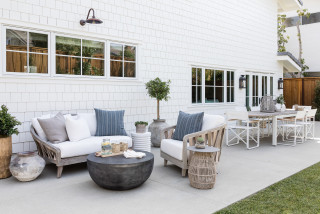
This article was originally published by a www.houzz.com . Read the Original article here. .

This article was originally published by a www.houzz.com . Read the Original article here. .
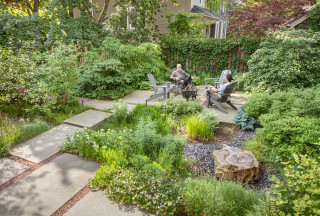
While many of us are aiming to keep hard landscaping to a minimum in our gardens, a patio surface is a must if you want somewhere to set up a stable dining table or outdoor sofa. Luckily, it’s possible to create a paved or gravel area that’s both sustainable and perfect for a well-functioning patio.
Consider asking your builder or landscaper to use reclaimed materials, such as flagstones, cobblestones or bricks. Not only will they have a smaller carbon footprint, they’ll have a timeless feel that will contribute to the relaxed mood. Permeable materials, such as gravel and decomposed granite, provide a firm surface for furniture while keeping rainwater on-site. Responsibly sourced wood decking or composite decking made from recycled materials are good options too.
Also think about creating pockets of greenery amid the paving to soften the feel and aid drainage. As long as you have a large enough area to hold furniture legs, some paving stones, bricks or decking boards could be skipped in favor of low-growing plants, such as baby’s tears (Soleirolia soleirolii, USDA zones 9 to 11; find your zone), woolly thyme (Thymus pseudolanuginosus, zones 5 to 8) or small succulents set into gravel, to bring greenery up close.
Find a landscape designer near you on Houzz
This article was originally published by a www.houzz.com . Read the Original article here. .

Himschoot planted the beds with a mix of perennials, grasses and shrubs for nearly year-round color and interest. Perennials include ‘Summer Beauty’ allium (Allium ‘Summer Beauty’, USDA zones 4 to 9; find your zone), ‘Visions’ astilbe (Astilbe chinensis ‘Visions’, zones 4 to 9), ‘Walker’s Low’ catmint (Nepeta racemosa ‘Walker’s Low’, zones 3 to 8), ‘Little Spire’ Russian sage (Perovskia atriplicifolia ‘Little Spire’, zones 5 to 9), ‘Blue Mouse Ears’ hosta (Hosta ‘Blue Mouse Ears’, zones 3 to 9) and ‘Petite Delight’ beebalm (Monarda didyma ‘Petite Delight’, zones 3 to 9).
The grasses are golden Japanese forest grass (Hakonechloa macra ‘Aureola’, zones 4 to 9), ‘Ice Dance’ Japanese sedge (Carex morrowii ‘Ice Dance’, zones 5 to 9) and ‘Bowles Golden’ sedge (Carex elata ‘Aurea’, zones 5 to 9).
The shrubs include ‘Ruby Slippers’ oakleaf hydrangea (Hydrangea quercifolia ‘Ruby Slippers’, zones 5 to 9), dwarf fothergilla (Fothergilla gardenii, zones 5 to 8), ‘Blue Star’ juniper (Juniperus squamata ‘Blue Star’, zones 4 to 8) and ‘Little Devil’ ninebark (Physocarpus opulifolius ‘Donna May’, zones 3 to 7).
This article was originally published by a www.houzz.com . Read the Original article here. .
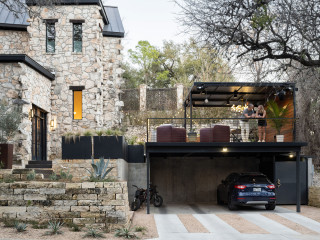
“This project required a variance, and the permitting process was long and challenging,” project manager Bob Perez says. “From the time the architects started the design to the time we finished building was about two years.” Luckily, the couple’s patience paid off. They now have a two-car carport, a protected bike garage, a reworked entry and an expanded patio that includes an outdoor kitchen, a covered area and full smart home technology outdoors for fans, heaters, lighting, speakers and misters.
This article was originally published by a www.houzz.com . Read the Original article here. .
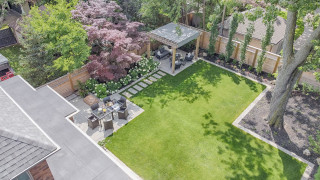
In addition, Zalewski added trees and shrubs for privacy and beauty, and redesigned the side yard. He kept easy maintenance at the front of his mind throughout the process. He also considered the master plan he’d drafted for the entire property. Later phases will include adding an outdoor kitchen and reworking the front yard.
This article was originally published by a www.houzz.com . Read the Original article here. .
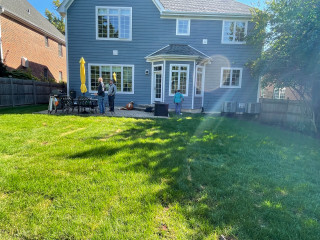
“The architecture of the house was quite traditional and it was important to us to make the landscape cohesive with the house,” Algozzini says. “There are multiple ways you can install a gaucho grill, and it can be a standalone piece. But after looking through images with my clients to see what they liked, I proposed we move it into a fireplace that would be integrated into a pavilion.”
Gaucho, or Argentine-style, grills use traditional cooking methods to produce foods with rich, smoky flavor. Typically, meat is grilled on a grate over wood embers or charcoal. The signature wheel or crank allows you to adjust the grate’s height to control cooking temperature and time.
10 Outdoor Kitchen Design Features Pros Always Recommend
This article was originally published by a www.houzz.com . Read the Original article here. .
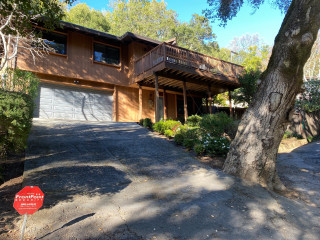
Look closely at the left side of this photo, where the original siding meets the new fiber cement siding, to see a thoughtful detail. The new siding juts out from the rest of the facade. “This added a thickness and clearly defined the entry and the area underneath the deck,” Shoup says.
This is an “upside-down” house, meaning the bedrooms are on the ground floor, and the living room opens onto the deck. The deck also can be viewed from the kitchen, as the floor plan is open. It’s easy for the homeowners to pour themselves a cup of coffee in the morning and then enjoy it outside among the tree canopies.
This article was originally published by a www.houzz.com . Read the Original article here. .
Sometimes, the simplest approach is also the most rewarding. Patio surfaces are designed to take a lot of wear and tear, so you may not notice when they’re not looking quite as pristine as they once were.
To keep patios looking their best, take a day to give the space a good cleaning. Clear off the moveable furnishings, sweep the floor well and then wash or treat the surface with the appropriate cleanser. Often, a mix of warm water and dish detergent, plus a sturdy broom, is sufficient. Let it dry, then put everything back in place.
While you’re at it, clean any cushions and patio furnishings that have become a bit grungy or stained. Usually scrubbing items with a solution of warm water and dish detergent, then rinsing them and letting them dry, is all that’s needed. You may have to work a bit to get off stubborn stains, but the clean look will be worth it.
Find a landscape contractor